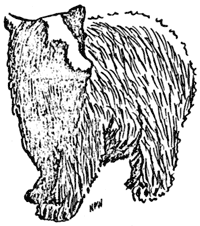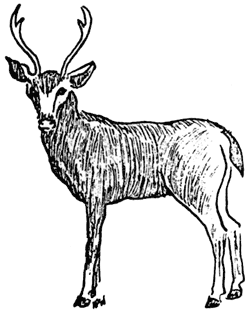Mammal Populations, 1946
 Olympic black bear are not numerous as compared with pre-war years. The policy of garbage disposal at a considerable distance from any habited area has been successful in preventing unhealthy concentration of these animals. A few complaints have been made by campers of bears stealing foodstuffs left exposed in a vacated camp but these indignant people are outnumbered twenty to one by visitors equally indignant because they haven’t seen a bear since they entered the park.This note is based upon observations, made in Crater Lake National Park, upon the most easily observable mammal species. The present season is distinct in two particulars: The park is open to the heavy public travel for the first time since 1942. The heavy snowfall of the 1945-46 season has provided an exceptional amount of vegetation throughout the area.
Olympic black bear are not numerous as compared with pre-war years. The policy of garbage disposal at a considerable distance from any habited area has been successful in preventing unhealthy concentration of these animals. A few complaints have been made by campers of bears stealing foodstuffs left exposed in a vacated camp but these indignant people are outnumbered twenty to one by visitors equally indignant because they haven’t seen a bear since they entered the park.This note is based upon observations, made in Crater Lake National Park, upon the most easily observable mammal species. The present season is distinct in two particulars: The park is open to the heavy public travel for the first time since 1942. The heavy snowfall of the 1945-46 season has provided an exceptional amount of vegetation throughout the area.
Columbia black-tailed deer appear to be exceptionally numerous. They are commonly seen by visitors and trails are found to be dotted with fresh footprints whenever they are visited. Deer are commoner than at any season in the last then years.
Golden mantled ground squirrels are rather scarce. In 1938 about 150 squirrels, by actual count, inhabited the rim area between the Lodge and the Crater Wall Trail. This year’s population appears to be about one-fifth of this. Squirrels are very numerous along Highway 230 east, outside the park.
Townsend chipmunks, never very numerous, appear in expected numbers. Klamath chipmunks have been rarely observed in the rim area this year. White-footed mice, which in the rim area sometimes enter the cafeteria or lodge in considerable numbers, have caused no comment this year and appear to be below average in number. A few have been taken in snap traps along Munson Creek.
Yellow-bellied marmots may be seen to some extent along the highways. None has been observed along the Rim Walk, where one or two could usually be seen. Conies can be seen in the talus slopes along Garfield Peak Trails but do not call from the rim slopes to any extent this year. They appear to be present in less than average number.
Signs of the Mazama gopher showed in a few places along the rim where the snow melted. The most extensive workings in the rim area were in a small flat between the highway and the cafeteria. When it is considered that spring melts commonly expose extensive gopher workings in cleared spaced everywhere in the park area, the numbers of gophers this year can be considered below average.
Among the medium sized and small carnivores, pine martens have been reported to be about as numerous as usual. A weasel carrying a Microtus and, later, the same individual carrying a small Citellus, was seen at the Information Building. Coyotes have not been reported at all and foxes rarely.


